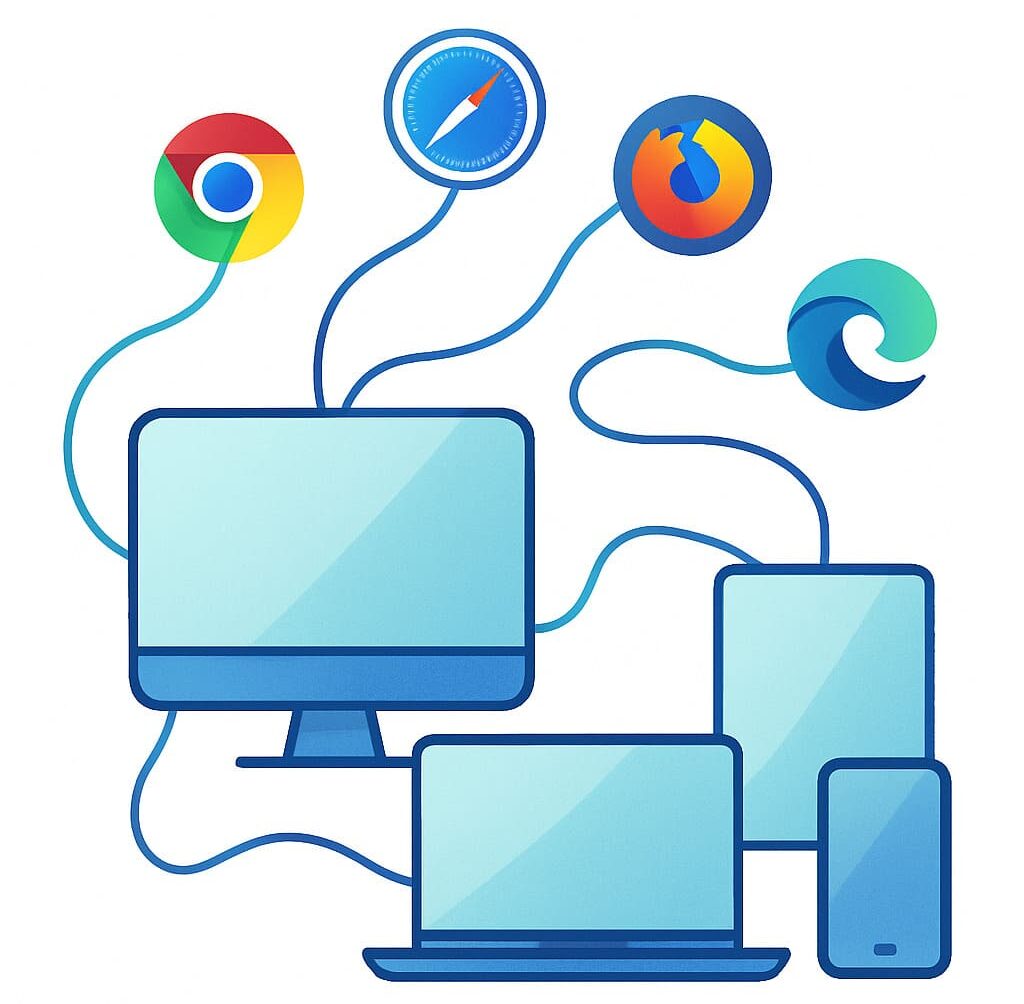A Beginner’s Guide to Cross-Browser and Cross-Platform Testing

In today’s digital-first world, we view websites and apps across a range of devices and browsers. Having a fluid and unified experience in all these environments is no longer optional; it’s essential for operational efficiency. Here comes the cross-browser and cross-platform testing into play. Whether it’s a consumer web-based application or a corporate intranet portal, consistent cross-platform and browser behavior is crucial, and users simply leave once they start experiencing difficulty or frustration.
This guide is a book of practices that is useful for both beginners and professionals to perform cross-browser and cross-platform testing effectively, including basic principles, differences, challenges, tools, and modern best practices that testers or QA’s need to know.
- What is Cross-platform Testing and Cross-browser Testing
- What is Cross-Platform Testing?
- What is Cross-Browser Testing?
- Key Differences Between Cross-Browser and Cross-Platform Testing
- Challenges in Cross-Browser and Platform Testing
- Building a Test Matrix for Browser and Platform Coverage
- Best Practices for Effective Testing
- Automation Strategies and Tools
- Must-Have Features in Cross Testing Tools
- Real-World Scenarios That Demand Cross Testing
- Future Trends in Cross Testing
- Conclusion
What is Cross-platform Testing and Cross-browser Testing – Why It Matters Together
Applications these days need to run on several environments simultaneously. That’s where cross-browser and platform testing comes in as a key strategy. If someone moves from a Chrome browser on Windows to Safari on iOS, or from desktop to mobile, every layer of your application, from frontend rendering to backend integrations, needs to be able to respond.
Ignoring these forms of flexibility results in broken layouts, terrible performance, or even worse, functional failures, which will send users elsewhere.

What is Cross-Platform Testing?
Cross-platform testing is making sure your app behaves consistently across multiple operating systems and devices. The intention is to guarantee some compatibility and some (raw) performance on:
- Android
- iOS
- Windows
- macOS
- Linux
- Tablets, wearables, desktops, and more
For instance, an iOS banking mobile app might act slightly different from a banking mobile app for Android because of the variation between the two platforms’ UI guidelines or APIs. Cross-platform testing is useful for detecting such inconsistencies in the early stages.
Mobile Compatibility Testing
Mobile platforms introduce additional complexity due to device-specific UI behaviors, gesture handling, and varying screen resolutions. A navigation bar that appears perfectly on a Samsung Galaxy may misalign on an iPhone.
Cross-platform testing must account for mobile compatibility by testing across:
- Multiple screen sizes and aspect ratios
- iOS vs Android differences
- Touch interactions and gestures
What is Cross-Browser Testing?
Cross-browser testing ensures that your website or web application functions as expected across various web browsers and their respective versions. Browsers like:
- Google Chrome
- Mozilla Firefox
- Safari
- Microsoft Edge
Each interprets HTML, CSS, and JavaScript slightly differently due to their underlying rendering engines.
Browser Compatibility Considerations
The rendering engine makes a major impact:
- Blink (used by Chrome, Edge)
- WebKit (used by Safari)
- Gecko (used by Firefox)
Even minor inconsistencies in engine behavior can cause layout shifts, broken buttons, or misaligned components.
Key Differences Between Cross-Browser and Cross-Platform Testing
Understanding the difference between cross-browser and cross-platform testing helps build more targeted QA strategies. One focuses on how content is rendered in browsers, while the other ensures the application logic works on different platforms.
| Aspect | Cross-Browser Testing | Cross-Platform Testing |
|---|---|---|
| Focus | Web browsers and their versions | Operating systems and devices |
| Primary concern | Rendering, layout, and JavaScript compatibility | Functional consistency and performance |
| Examples | Chrome vs. Firefox vs. Safari | Android vs. iOS, Windows vs. macOS |
| Test surface | Mostly frontend (UI and client-side scripts) | Frontend and backend behaviors, native APIs |
Challenges in Cross-Browser and Platform Testing
Cross-browser and platform testing introduces several unique challenges:
- Device and browser fragmentation: Thousands of combinations exist with OS versions, browsers, and screen resolutions.
- Inconsistent rendering engines: Blink (Chrome), WebKit (Safari), and Gecko (Firefox) render HTML/CSS differently.
- Network and performance variability: A site may load fast on a desktop but slow on mobile.
- Third-party dependencies: Plugins, libraries, or fonts may behave differently across platforms.
Building a Test Matrix for Browser and Platform Coverage
A well-defined test matrix helps prioritize what combinations to test. Here’s a sample breakdown:
| Platform | Browsers | Devices |
|---|---|---|
| Windows 11 | Chrome, Edge | Laptop/Desktop |
| macOS Ventura | Safari, Chrome | MacBook, iMac |
| Android 13 | Chrome | Samsung, Pixel phones |
| iOS 17 | Safari, Chrome | iPhone 14, iPads |
Focus on high-traffic platforms identified via analytics tools like Google Analytics or Mixpanel.
Best Practices for Effective Testing
- Start with a responsive design: Ensure your UI is mobile-first and adaptable.
- Test on real devices and emulators: Emulators are useful, but real devices give the most accurate results.
- Use visual validation tools: These tools catch layout bugs through visual regression testing.
- Automate repetitive tests: Automation helps reduce effort, especially across multiple environments.
Automation Strategies and Tools
Automating cross-browser and cross-platform testing can dramatically improve test coverage and efficiency.
ACCELQ, for instance, is an AI-powered, codeless platform with end-to-end automation that enables unified automation for both mobile and web platforms using a natural language interface. Its robust cross-platform test design helps maintain test reliability despite complex enterprise landscapes.
Must-Have Features in Cross Testing Tools
When choosing a testing platform, look for the following features:
- Support for multiple browsers and platforms
- CI/CD pipeline integration for faster feedback
- Local testing + remote device debugging
- Visual regression testing for catching layout drifts
- Test versioning, collaboration & reporting
ACCELQ offers referential integrity across test assets, test management, and intelligent test design making it suitable for enterprise QA teams seeking scalability and simplicity.
Real-World Scenarios That Demand Cross Testing
- eCommerce: Ensure shopping carts work on Android, iOS, Safari, and Chrome.
- Banking apps: Authentication flows must function across OS/browser combinations.
- Government portals: Must remain accessible across legacy and modern platforms.
Future Trends in Cross Testing
- Visual regression testing: Automates the detection of UI shifts between builds using pixel-diff technology.
- AI-assisted test generation: Tools like ACCELQ leverage AI to auto-generate test cases and optimize test paths.
- Cloud-based grid execution: Enables testing across thousands of environments without infrastructure overhead.
- Smart analytics and heatmaps: Help teams identify which devices/browsers to prioritize based on user behavior.
Conclusion
Delivering consistent performance and visual quality across a broad spectrum of browsers and platforms is no longer an option, it’s a requirement. Users are accessing the applications in a cross-device, cross-OS and cross-browser way, and it has become very challenging in the competitive world for businesses not to have a strong cross-browser and cross-platform testing strategy in place. This is a great way that user experience isn’t compromised, but also reduces the possibility of last-minute bugs or post-launch failures that could damage the brand.
By incorporating sophisticated automation tools, such as ACCELQ, QA teams have made it easier to manage testing workflows more efficiently, obtain wider coverage, and roll out updates more confidently. In the future, trends like the application of machine learning to testing or the popularization of visual regression testing are expected. The companies that make mobile and browser-inclusive testing part of their best practices today are the ones that will have the ability to provide sustainable digital experiences with user-first digital experiences in the future.
You Might Also Like:
 AI Automation in Testing: The Future of Smarter, Scalable QA
AI Automation in Testing: The Future of Smarter, Scalable QA
AI Automation in Testing: The Future of Smarter, Scalable QA
 The Top 7 UI Test Automation Best Practices
The Top 7 UI Test Automation Best Practices
The Top 7 UI Test Automation Best Practices
 How to use Selenium Testing with ACCELQ?
How to use Selenium Testing with ACCELQ?
































